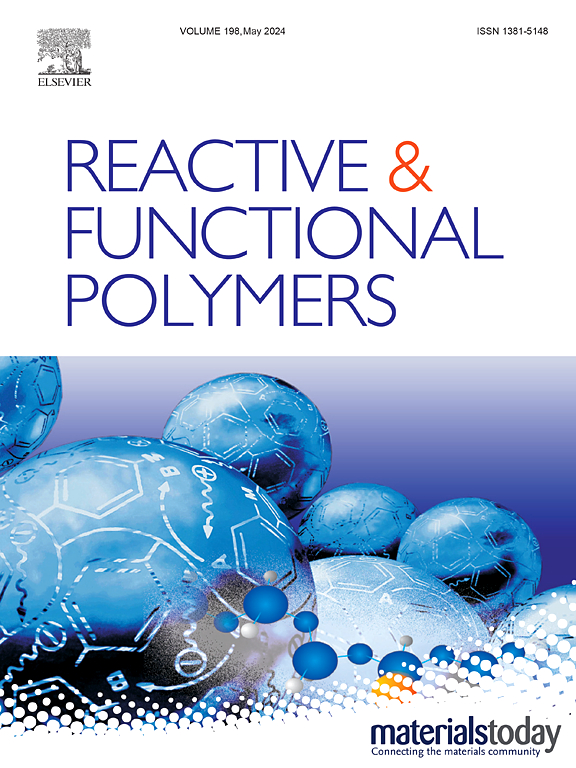戊二酰硫脲交联新型水凝胶的研制与表征详细分析生物相容性、血管生成和抗菌潜力
IF 5.1
3区 工程技术
Q1 CHEMISTRY, APPLIED
引用次数: 0
摘要
在本研究中,我们通过与不同浓度的戊二酰二异硫氰酸酯(GTU)进行交联,成功合成了四种新型壳聚糖水凝胶。这种深思熟虑的方法不仅赋予聚合物薄膜一种微妙的淡黄色,而且还增强了它们作为生物材料的潜在应用。利用FTIR、XRD和CHNS分析的综合表征为水凝胶基质内成功的化学相互作用提供了重要的见解。扫描电子显微镜(SEM)显示薄膜具有明确的多孔结构。热降解分析表明,与纯壳聚糖的303°C相比,交联水凝胶GTU-CS4在270°C时失重50%,表明交联引起的热稳定性降低是可控的。力学测试表明,将交联剂浓度增加1.2 mmol可使水凝胶膜的伸长率达到令人印象深刻的30.64%,而纯壳聚糖的伸长率为18%,突出了柔韧性和强度的显著提高。我们的生物学评估表明,较高的交联剂浓度可以有效地减少炎症并促进血管生成,血管形成增加到28条血管,并增强转化生长因子-β1 (TGF-β1)的表达。WST-8实验显示细胞活力显著增加,在交联水凝胶中达到高达180%。此外,抗菌试验表明,对金黄色葡萄球菌的抑制率为80%,对大肠杆菌的抑制率为60%。这些发现强调了gtu交联壳聚糖水凝胶在推进皮肤组织再生应用方面的巨大潜力。本文章由计算机程序翻译,如有差异,请以英文原文为准。

Development and characterization of glutaryl thiourea crosslinked novel hydrogel; a detailed analysis of biocompatibility, angiogenesis, and antibacterial potential
In this study, we successfully synthesized four novel chitosan hydrogels by carefully crosslinking them with varying concentrations of glutaryl di-isothiocyanate (GTU). This thoughtful approach not only imparts a subtle yellowish tint to the polymer films but also enhances their potential applications as biomaterials. Comprehensive characterization using FTIR, XRD, and CHNS analyses provided important insights into the successful chemical interactions within the hydrogel matrix. Scanning electron microscopy (SEM) revealed a well-defined porous microstructure in the films. Thermal degradation analysis indicated that 50 % weight loss occurred at 270 °C for the crosslinked hydrogel GTU-CS4, compared to 303 °C for pure chitosan, suggesting a manageable decrease in thermal stability due to crosslinking. Mechanical testing showed that increasing the crosslinker concentration by 1.2 mmol resulted in an impressive percentage elongation of the hydrogel films at 30.64 %, in contrast to 18 % for pure chitosan, highlighting significant improvements in flexibility and strength. Our biological evaluations suggested that higher crosslinker concentrations effectively reduced inflammation and promoted angiogenesis, with blood vessel formation increasing to 28 vessels and an enhanced expression of transforming growth factor-beta 1 (TGF-β1). The WST-8 assay demonstrated a noteworthy increase in cell viability, reaching as high as 180 % in the crosslinked hydrogels. Additionally, antibacterial tests showed promising inhibition rates of 80 % against Staphylococcus aureus and 60 % against Escherichia coli. These findings underscore the considerable potential of GTU-crosslinked chitosan hydrogels in advancing skin tissue regeneration applications,
求助全文
通过发布文献求助,成功后即可免费获取论文全文。
去求助
来源期刊

Reactive & Functional Polymers
工程技术-高分子科学
CiteScore
8.90
自引率
5.90%
发文量
259
审稿时长
27 days
期刊介绍:
Reactive & Functional Polymers provides a forum to disseminate original ideas, concepts and developments in the science and technology of polymers with functional groups, which impart specific chemical reactivity or physical, chemical, structural, biological, and pharmacological functionality. The scope covers organic polymers, acting for instance as reagents, catalysts, templates, ion-exchangers, selective sorbents, chelating or antimicrobial agents, drug carriers, sensors, membranes, and hydrogels. This also includes reactive cross-linkable prepolymers and high-performance thermosetting polymers, natural or degradable polymers, conducting polymers, and porous polymers.
Original research articles must contain thorough molecular and material characterization data on synthesis of the above polymers in combination with their applications. Applications include but are not limited to catalysis, water or effluent treatment, separations and recovery, electronics and information storage, energy conversion, encapsulation, or adhesion.
 求助内容:
求助内容: 应助结果提醒方式:
应助结果提醒方式:


